If you’re an industry expert, trainer or consultant, you would have definitely tried numerous ways to promote online courses. Didn’t satisfied with outcomes? Search Engine Marketing can help.
Targeting the folks who might not be interested in your courses can turn down your online brand reputation. So, don’t you think you should invest your time and energy in filtering out those who are actually looking for your courses? Online advertising with Google Ads gives the opportunity to the trainers like you to reach out to the potential customers looking for the e-learning courses and online classes that you offer.
Hello and welcome! In this blog, I’ll walk you through with a powerful strategy for promoting courses online using Google Ads and how easily you can track the metrics and perform remarketing. Let’s get started!
Table of Contents Include:
- Introduction to Google Ads
- Setup Google Ads Account
- Define Business Objectives
- Google Ads Campaign Types to Promote Online Courses
- Select Targeting & Audiences
- Budget and Bidding
- Setup Ad Groups for your online courses
- Create a keyword list
- Create a Compelling Ad Copy
- Track Conversions of Your Ads
- Remarketing of Your Ad Campaigns
Table of content
Introduction to Google Ads
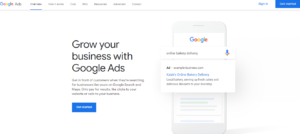
Google Ads is an online advertising program offered by Google to its users. It allows creating, managing, and running successful ad campaigns and helps you turn your advertising investment into revenue.
Formerly, Google Ads was known as Google Adwords.
For course instructors and trainers who want to run advertisements on Google Search and Maps, it offers the right platform to get their courses in front of students or learners who are searching for these kinds of courses by paying only when the desired outcomes are met. For example, impressions, clicks, conversions, target return on ad spent, etc.
Google Ads is a digital advertising solution that helps you reach the target audience and transform them into valuable customers.
-Google Ads
Setup Google Ads Account
Creating an account on Google Ads is not a difficult task. All you need is a Gmail id. Follow the steps mentioned below and set up your Google Ads account.
- Visit Google Ads platform.
- Click on the “Get Started” button on the top right.
- Select your Gmail Id.
And, start creating your campaign.
Define Your Objective
Before start creating a campaign on Google Ads, you must first define your business objectives beforehand. It helps you prepare your campaign further. The business objectives for your e-learning website can be:
- Sale of your online courses
- Getting leads for your new online courses
- Increase website visits
- Encouraging your potential learners to explore your courses
- Building brand awareness
- Promoting your e-learning app for online education
Google Ads Campaign Types to Promote Online Courses
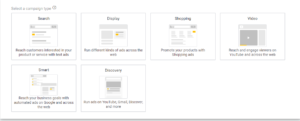
In order to run your ads effectively and getting the desired results from investment, you need to invest your ads budget where you think that the results are fruitful. This is where the role of campaign types comes into play.
Based on your business objective, you can determine the campaign type for your ads. It helps you determine the ad’s placement and format properly.
For online course promotion, you can select from the following campaign types:
1. Search Campaign: When students look for the online courses, institutes, education, etc. like yours, your Search Ads appear in:
- Google search results
- On other Google partner sites, like YouTube.
2. Display Campaign: Google Display ads can appear across a network of more than two million sites and apps. It helps in increasing exposure and reaching audiences with specific interests across the web.
3. Video Campaign: Video campaigns allow you to display your ads on your own or within other streaming video content on YouTube and across Google’s network of websites and apps. Only pay when people choose to watch your ad.
4. Shopping Campaign: Shopping campaign is useful for those who want to boost traffic to a website or local store. If you have a local store selling books or products related to your institute, you can prefer this. The ads appear on Google Shopping next to search results and near text and responsive ads. It provides consumers detailed information about what you’re selling before they even select your ad.
5. App Campaign: App campaigns run ads across Google Search, Play, and YouTube, as well as thousands of mobile sites and apps.
With an App campaign, you can increase engagement, app installs for your education website, and even in-app actions, like signing up for a newsletter or ordering a product.
6. Smart Campaign: Smart campaigns will help your online education website get discovered on Google in relevant moments. It brings you results based on your ad goal like customer calls, visits to your store, or actions on your website.
It lets you run automated ads that show on Google, Google Maps, and across the web, and take advantage of minimal hands-on ads management.
7. Discovery Campaign: Use the discovery campaign for visually rich personalized ads. The ads get displayed across YouTube, Gmail, Discover, and more. For this campaign to work, you need to first set up conversion tracking in your account.
Also learn: How to make money through online courses
Select Targeting & Audiences
Next, you need to select the audience whom you want to reach. You can select from three targeting options:
- Location Targeting: Select whether you want to promote your courses online to all the countries and territories or to a specific location.
- Language Targeting: This lets you target audience who speaks and understand a specific language so that you can easily send your message to them.
- Audiences: Audience targeting lets you decide who will be your target audience. You can create new audiences in Audience Manager.
Budget and Bidding
Since you’re investing on Google Ads platform, it’s recommended to understand about the budget and bidding options in Google Ads. This option lets you define how much you want to spend and how you want to spend it.
- Budget: Define the average amount you want to spend each day. In a particular month, you won’t pay more than your daily budget times the average number of days in a month. Some days you might spend less than your daily budget, and on others, you might spend up to twice as much based on the various factors.
- Bidding: Define whether you want to focus on automated bid strategies or manual bid strategy. Automated bid strategies include clicks, impression share, conversions, or views. Manual bid strategy includes Manual CPC that lets you set your own maximum cost-per-click for your ads.
Setup Ad Groups For Your Online Courses
An ad group contains a set of one or more ads and target keywords. Try to put the ads and keywords in one ad group that relates to one product or service.
Say, for example, you want to promote your online marketing course. Your Ad Group to promote online course can be like this:
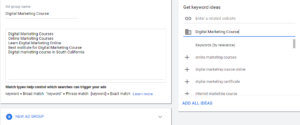
Create a Keyword List

For example, if you want to advertise your online marketing course, you have to find out what phrases and words are being used by the learners who are interested in this course.
You can choose from 5 match types to target your keywords.
- Broad match (default match type): Use this to display ads for keyword including its variations like misspellings, synonyms, or related searches. For Example, Learn Digital Marketing Online
- Broad match modifier: Use this to display ads only if the keyword or its close variations are in any part of the search terms. Use a “+” sign in front of a keyword. For example, +Learn +Digital +Marketing Online in South California
- Phrase Match: Display ads only if the keywords within the quotation marks or close variations of them match a user’s search term. For example, “Learn Digital Marketing Online in South California”
- Exact match: Display ads for the exact search terms or for the keyword that has a same meaning as your keyword has. For example [Digital Marketing Course in South California] or [Learn Digital Marketing in South California]
- Negative keywords: Adding a minus sign in front of the keyword won’t allow your ad to show up for the wrong searches.
You can compile an effective keyword list by researching keywords in your industry using Keyword Research tools. The most recommended Keyword Research tool is Google Keyword Planner.
Google Keyword Planner
Google Ads provides you with this free keyword research tool to discover new keywords and get search volume and forecasts for how they might perform in the future.
1. Discover New Ideas:
Just enter a keyword that relates to your business. Select the target location & language. You’ll see how Google Keyword Planner tool provides you with lots of keyword ideas that you can use for your business.
Say, for example, here, I’m using “Digital Marketing Course Online” as a keyword for South Carolina as a target location. Look how I got the results:
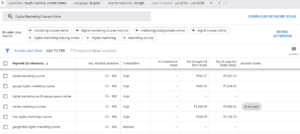
2. Get search volume and forecasts:
This lets you enter your keywords list and will show you the historical metrics and forecasts of those keywords. For example, here I’ve added 5 keywords related to digital marketing courses and see how it provides me the forecasts on them:
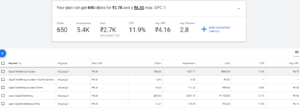
And, this is the historical metrics of selected keywords:
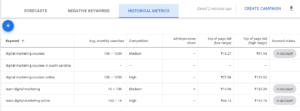
So, this is how you can use this tool to create a list of effective keywords. Apart from Google Keyword Planner, you can use many other tools to research keywords to promote your online courses. A few of them are as under:
- Google Trends
- Google Suggestions
- Keywords.io
- Ubersuggest
- Keywords Finder
Create a Compelling Ad Copy
If you’ve chosen a Search Campaign, it’s time to start writing an ad copy for your course promotion. For a search campaign, your ad must include:
- Headline – To catch the learners’ attention
- URL – To reach a particular page on your e-learning site
- Description – To highlight the details of what your course program is offering.
Here is an example of an effective ad copy:

Also learn: What are social learning websites
Track Conversions of Your Ads
Won’t you like to know how your ads are performing? Obviously, you would! You can track which keywords, ads, ad groups, and campaigns are the best at driving value to your business. Conversion Tracking tool provided by Google lets you track the progress of your running ads which is beneficial to implement ad optimization practices.
Remarketing of Your Ad Campaigns
Remarketing is helpful to display ads to the people who have visited your site by clicking your ad but not converted into your customers yet. You can create a list of website visitors or app users gathered by snippets of code added to your site or app. Moreover, you can also create a remarketing list for YouTube users, customized list of customers, or from a custom combination.
You can set the rules for when visitors or users should be added to your remarketing list. Once created, add this list to your campaigns’ ad group targeting. This will help you display ads to visitors or users that comes under your lists.
You’ll find the option to create remarketing lists under the Audience Manager tool.
Launch Your First Ad Campaign Now!
Hopefully, this guide has helped you on how to promote online courses using Google Ads. And, we definitely want to hear about your ad experience. Do share your comments below.
And, here is something special for you.
If you want to start your e-learning website quickly without coding from scratch, you can use our WordPress LMS theme: LearnMate dedicated to LearnDash LMS plugin.
Download here: WordPress LMS Theme
Stay tuned!






